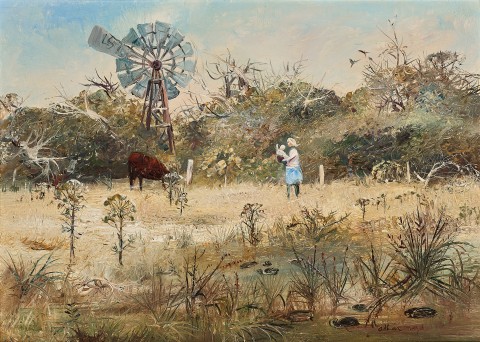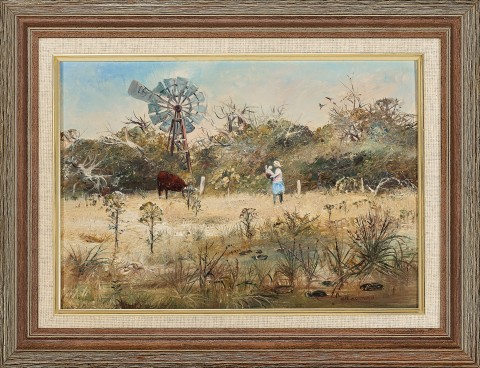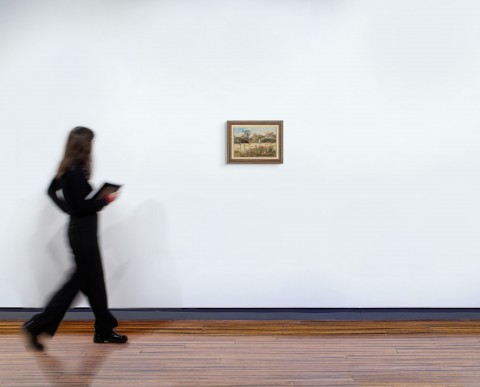The windmill, c.1959
Arthur Boyd
oil on composition board
25.5 x 35.5 cm
signed lower right: Arthur Boyd
Australian Galleries, Melbourne
Mrs R. J. Anderson, Beaumont, Texas, USA, acquired from the above
Thence by descent
Ross Anderson, Texas, USA, 1977
Thence by descent
Mary Anderson, Texas, USA, 1980
Rago Auctions, Lambertville, New Jersey, USA, 11 June 2025, lot 168
Private collection, Melbourne
Philipp, F., Arthur Boyd, Thames and Hudson, London, 1967, cat. 8.59, p. 256
Arthur Boyd’s paintings of the Victorian countryside, produced in the late 1950s before he departed for England in 1959, comprise the artist’s most exhaustive exploration of the genre since his highly acclaimed Berwick and Wimmera series from 1948 to 1951. Displaying an intimate and subjective response to rural living, The windmill, c.1959, recalls the ‘landscapes of love’ produced during Boyd’s time at Berwick with his young family.1 This small pastoral scene is a window into quotidian life, presenting a tender view of a mother and child exploring the home paddock, safely enclosed by a fence line and a tangled spinney.
Arthur Boyd’s dry, straw-toned landscapes of his home state are paintings of his childhood, youth and early adulthood, infused with truthful feeling and sharp observation. In contrast to the Shoalhaven riverine landscapes painted throughout the last decades of his life, these early Victorian works depict an inhabited landscape, humanised and cultivated. During this time, Boyd painted the landscape wherever possible, ‘showing Australians where they lived, mapping it, writing it home with his brush.’2 Although traces of the primeval and untamed forests of The Hunter series from the early 1940s remain in the claw-like white trees of these paintings, the landscape is no longer presented as a threat. The pair of figures comfortably embedded in this landscape possibly depicts the artist’s wife, Yvonne, and their third child, Lucy, born in 1958. Though small, they constitute the focal point of this landscape, the baby gesturing to the towering presence of the windmill. Incidentally employing the sky-blue hues traditionally associated with the Virgin Mary, Boyd’s figure group of a Madonna and child reinforces the dominant gold-and-blue chord of brilliant Australian sunshine in the bush.
This pastoral idyll, seen through a veil of tall thistles, rushes and weeds in the foreground, presents a rural Australian version of the hortus conclusus, the full and enclosed garden. While Boyd’s sparse Wimmera landscapes expressed the vastness and remoteness of inland Australia with a distant and shimmering horizon, here the horizon is obscured by a dense thicket of trees. The faithful windmill, an iconic silhouette of rural Australia, stands tall against the smooth blue sky, poking just above the textured line of vegetation. Alongside the small dam and grazing cow, the windmill is what Franz Philipp has called ‘motifs of habitation’, familiarising the wild bush into a warm and tranquil scene.3
Prior to leaving for England, where he would stay for twelve years, Boyd’s paintings of the Australian landscape received significant critical acclaim. Where previously Boyd's interpretations of the landscape had been modelled on European landscapes, his approach during this period became more personal and specifically Antipodean. When a number of these landscapes were exhibited for the first time at Australian Galleries, Melbourne in 1959, an enthusiastic Alan McCulloch exclaimed: ‘in these landscapes [Boyd] has come to an ‘old master’ phase, probably the best, if not his last.’4 The significance of Arthur Boyd’s reinterpretation of the traditional pastoral scene was further acknowledged in 1958, when his work was chosen to be presented alongside that of Arthur Streeton, together representing Australia at the Venice Biennale.
1. Margaret Plant, cited in Philipp, F., Arthur Boyd, Thames & Hudson, London, 1967, p. 64
2. Bungey, D., Arthur Boyd: a life, Allen and Unwin, Sydney, 2007, p. 248
3. Philipp, F., op cit., p. 60
4. McCulloch, A., Herald, Melbourne, 14 April 1959
LUCIE REEVES-SMITH


